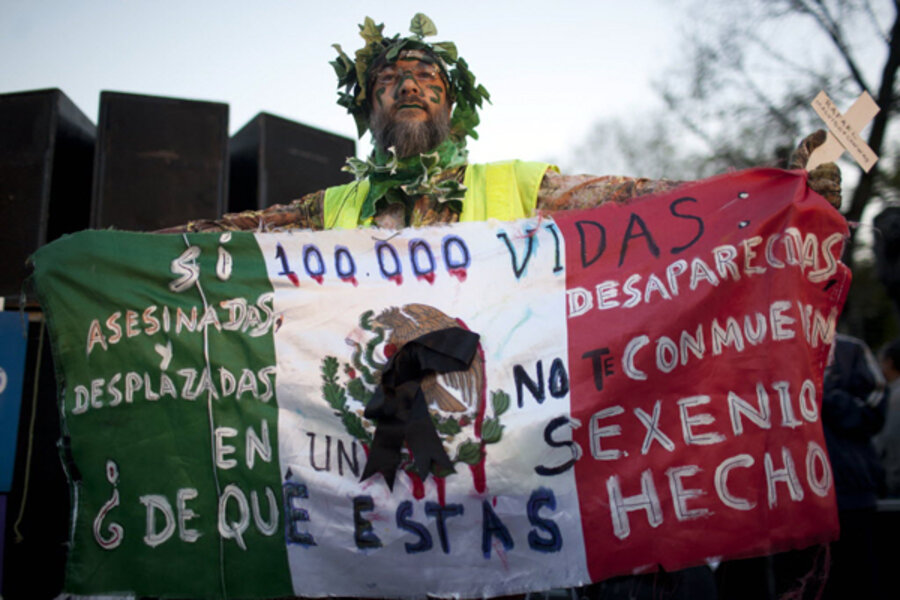Who is a victim in Mexico's drug war violence?
Loading...
| Mexico City
The rusted steel slabs of a new memorial to victims of Mexico’s drug war bear no mark, not a single engraved name, of anyone among the estimated 60,000 killed in the past six years.
As part of the concept, it will be up to the survivors to write in loved ones’ names.
After all, there is no way to know exactly who the dead are, since the official death toll of the fight against organized crime was suspended last year. Nor is it possible to know the reason why many were killed given that more than 96 percent of crimes go unsolved and unpunished in Mexico. Mexican society is wrestling with exactly who is a victim and who isn’t, and the memorial could serve as a touchstone to bring victimhood to the forefront of the national conversation.
As if reflecting that uncertainty, the slabs serve as a blank slate: Names scrawled on can also later be erased.
“We truly need a dose of transparency,” says Daniel Gershenson, an activist for victims’ rights. “We don’t know how many victims there are.”
'Opportunity to name the victims'
The memorial – yet to be opened to the public and shadowed by controversy arising from a rift among victims' groups over the monument – rises like a forest of dark panels on a corner of the capital’s heavily trafficked Reforma Avenue. Former President Felipe Calderón announced in November he would inaugurate the monument, but did not do so before leaving office Dec. 1. The slabs – erected next to military field known as Campo Marte, a tribute to the Roman god of war – tower above the white tarps, half collapsed, that currently enclose the memorial grounds covered with fallen leaves.
A spokesman for President Enrique Peña Nieto said the new president will inaugurate the memorial, but no date is set.
An increasingly vocal victims’ movement, although not always unified, has grown more demanding as the number of homicides continues to rise since Mr. Calderón launched the fight on organized crime six years ago. Victims and their advocates want the broken justice system reformed and a law passed to recognize and protect them.
They also wanted a memorial.
But the monument currently awaiting its debut divided Mexico’s victims’ groups, the most prominent of which are led by parents who have lost children to violent crime. Mexico S.O.S., founded by the gym and sportswear magnate Alejandro Martí, and Stop the Kidnapping, founded by Isabel Miranda de Wallace, who ran unsuccessfully for Mexico City mayor in the recent election as part of Calderón’s National Action Party, support the memorial. Each founder lost a son to brutal kidnappings by crime syndicates. But the Movement for Peace with Justice and Dignity, founded by the poet Javier Sicilia, opposes it.
Critics like Mr. Sicilia, whose son was killed by suspected cartel members, contend Calderón rushed the memorial without gaining consensus. In a dialogue with the administration a year ago, Sicilia proposed the government fund a trust so that civil society, victims, academics, and artists could envision a monument that would help heal the country’s wounds. Calderón initially agreed but then moved ahead with the monument that now stands, incorporating what some advocates say was limited public input.
“It was an opportunity to name the victims,” says Eduardo Vazquez, a spokesman for the movement. “We proposed a memorial that would be a place where people could bring their pain and share and pray. We wanted to involve society in order to raise consciousness.”
Defining victimhood
Part of the issue surrounding a memorial to victims is that Mexican society has yet to reach a consensus about what defines victimhood.
There are the civilians who have been killed in crossfire and activists who have been gunned down for speaking up. Others have died or disappeared at the hand of government forces. Dozens of journalists have been killed for their work. Many of the dead were likely killed in retribution for their work for one cartel or another. But given that the Mexican justice system can handle roughly 4,350 homicide investigations per year, according to research firm México Evalúa, and annual homicides top 20,000, it's next to impossible to assign or even absolve the dead of guilt.
And then there are the victims left behind. México Evalúa has developed a methodology to estimate the “invisible,” or indirect, victims of homicide in Mexico. For every homicide victim in Mexico, there are 3.4 indirect victims, such as a spouse, sibling, or child – 344,230 in the past six years alone.
President Peña Nieto has promised to attend to victims’ demands. He recently cleared the way for a proposed victims’ law to take effect after the legislation hit a wall with the Calderón government. The law would, among other things, provide reparations to families of victims of the drug war. Calderón noted the legislation doesn't establish where the money will come from to pay for those reparations; there are questions, too, about how "victim" should be defined.
Drug-related violence has recently stabilized in some regions and fallen in others, especially Ciudad Juárez and Tijuana south of the Texas border, due to a combination of effective law enforcement, crime prevention and social programs, and other factors. But even if that positive trend continues, it’s unlikely that survivors – the “invisible” victims of the drug war – will forget their pain, or quiet their pleas for justice.





